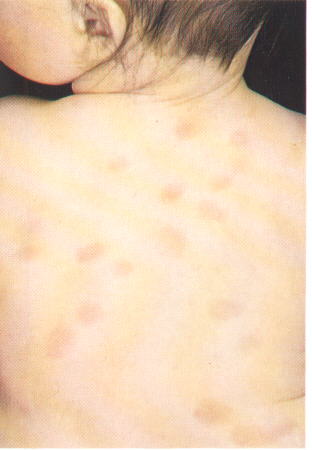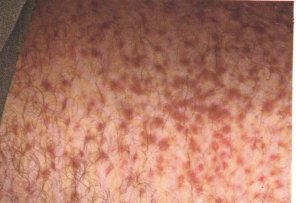
Flushing is a slowly spreading erythema of the skin due to a temporary dilatation of the capillaries. It can be caused by many conditions and is accompanied by light-headedness, a sense of suffocation, tremors, tinnitus and sometimes nausea and vomiting.
Menopausal flushing is extremely common around the time of menopause but may occur earilier following bilateral oophorectomy. This flushes, can last upto 15 minutes, may have associated sweating and develop spontaneously even during sleep.
Alcohol-induced flushing is related to the quantity and variety of drink consumed. Large amounts of histamine are found in sherry and some red wines.
With Carcinoid syndrome patients typically have diarrhea, dyspnea and right-sided heart lesions.
Patients with systemic mastocytosis have severe flushing attacks, often accompanied by headache, may occur spontaneously or after trauma to skin lesions.
This child's brownish macules which urticate on friction, are due to accumulation of mast cells in the upper dermis.

The childhood form usually resolves spontaneously after several years. The following picture shows the characteristic brownish macules turning to reddish urticating papules after being rubbed. Significant bone and visceral lesions may occur in adults.

Episodes of flushing and diarrhea may accompany Zollinger-Ellison syndrome and fainting with flushing can occur with pheochromocytoma.
In contrast, a flushed facial appearance is seen in patients with Cushing's syndrome, polycythemia rubra vera, and ACTH secreting bronchogenic tumors. Patients in thyrotoxic storm may appear flushed but do not complain of flushing often.
References: